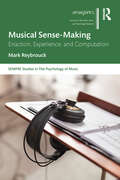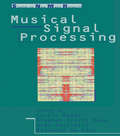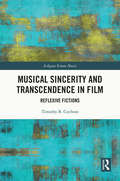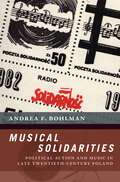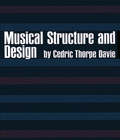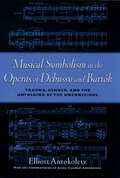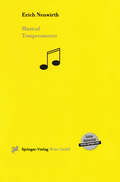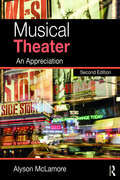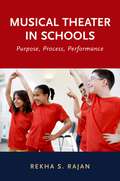- Table View
- List View
Musical Rhythm in the Age of Digital Reproduction (Ashgate Popular and Folk Music Series)
by Anne DanielsenMusical Rhythm in the Age of Digital Reproduction presents new insights into the study of musical rhythm through investigations of the micro-rhythmic design of groove-based music. The main purpose of the book is to investigate how technological mediation - in the age of digital music production tools - has influenced the design of rhythm at the micro level. Through close readings of technology-driven popular music genres, such as contemporary R&B, hip-hop, trip-hop, electro-pop, electronica, house and techno, as well as played folk music styles, the book sheds light on how investigations of the musical-temporal relationships of groove-based musics might be fruitfully pursued, in particular with regard to their micro-rhythmic features. This book is based on contributions to the project Rhythm in the Age of Digital Reproduction (RADR), a five-year research project running from 2004 to 2009 that was funded by the Norwegian Research Council.
Musical Rhythm in the Age of Digital Reproduction (Ashgate Popular and Folk Music Series)
by Anne DanielsenMusical Rhythm in the Age of Digital Reproduction presents new insights into the study of musical rhythm through investigations of the micro-rhythmic design of groove-based music. The main purpose of the book is to investigate how technological mediation - in the age of digital music production tools - has influenced the design of rhythm at the micro level. Through close readings of technology-driven popular music genres, such as contemporary R&B, hip-hop, trip-hop, electro-pop, electronica, house and techno, as well as played folk music styles, the book sheds light on how investigations of the musical-temporal relationships of groove-based musics might be fruitfully pursued, in particular with regard to their micro-rhythmic features. This book is based on contributions to the project Rhythm in the Age of Digital Reproduction (RADR), a five-year research project running from 2004 to 2009 that was funded by the Norwegian Research Council.
Musical Robots and Interactive Multimodal Systems (Springer Tracts in Advanced Robotics #74)
by Jorge Solis Kia NgMusical robotics is a multi- and trans-disciplinary research area involving a wide range of different domains that contribute to its development, including: computer science, multimodal interfaces and processing, artificial intelligence, electronics, robotics, mechatronics and more. A musical robot requires many different complex systems to work together; integrating musical representation, techniques, expressions, detailed analysis and controls, for both playing and listening. The development of interactive multimodal systems provides advancements which enable enhanced human-machine interaction and novel possibilities for embodied robotic platforms. This volume is focused on this highly exciting interdisciplinary field. This book consists of 14 chapters highlighting different aspects of musical activities and interactions, discussing cutting edge research related to interactive multimodal systems and their integration with robots to further enhance musical understanding, interpretation, performance, education and enjoyment. It is dichotomized into two sections: Section I focuses on understanding elements of musical performance and expression while Section II concentrates on musical robots and automated instruments. Musical Robots and Interactive Multimodal Systems provides an introduction and foundation for researchers, students and practitioners to key achievements and current research trends on interactive multimodal systems and musical robotics.
Musical Sense-Making: Enaction, Experience, and Computation (SEMPRE Studies in The Psychology of Music)
by Mark ReybrouckMusical Sense-Making: Enaction, Experience, and Computation broadens the scope of musical sense-making from a disembodied cognitivist approach to an experiential approach. Revolving around the definition of music as a temporal and sounding art, it argues for an interactional and experiential approach that brings together the richness of sensory experience and principles of cognitive economy. Starting from the major distinction between in-time and outside-of-time processing of the sounds, this volume provides a conceptual and operational framework for dealing with sounds in a real-time listening situation, relying heavily on the theoretical groundings of ecology, cybernetics, and systems theory, and stressing the role of epistemic interactions with the sounds. These interactions are considered from different perspectives, bringing together insights from previous theoretical groundings and more recent empirical research. The author’s findings are framed within the context of the broader field of enactive and embodied cognition, recent action and perception studies, and the emerging field of neurophenomenology and dynamical systems theory. This volume will particularly appeal to scholars and researchers interested in the intersection between music, philosophy, and/or psychology.
Musical Sense-Making: Enaction, Experience, and Computation (SEMPRE Studies in The Psychology of Music)
by Mark ReybrouckMusical Sense-Making: Enaction, Experience, and Computation broadens the scope of musical sense-making from a disembodied cognitivist approach to an experiential approach. Revolving around the definition of music as a temporal and sounding art, it argues for an interactional and experiential approach that brings together the richness of sensory experience and principles of cognitive economy. Starting from the major distinction between in-time and outside-of-time processing of the sounds, this volume provides a conceptual and operational framework for dealing with sounds in a real-time listening situation, relying heavily on the theoretical groundings of ecology, cybernetics, and systems theory, and stressing the role of epistemic interactions with the sounds. These interactions are considered from different perspectives, bringing together insights from previous theoretical groundings and more recent empirical research. The author’s findings are framed within the context of the broader field of enactive and embodied cognition, recent action and perception studies, and the emerging field of neurophenomenology and dynamical systems theory. This volume will particularly appeal to scholars and researchers interested in the intersection between music, philosophy, and/or psychology.
Musical Signal Processing (Studies On New Music Research)
by Curtis Roads Stephen Travis Pope Aldo Piccialli Giovanni De PoliFirst Published in 1997. Routledge is an imprint of Taylor & Francis, an informa company.
Musical Signal Processing
by Curtis Roads Stephen Travis Pope Aldo Piccialli Giovanni De PoliFirst Published in 1997. Routledge is an imprint of Taylor & Francis, an informa company.
Musical Sincerity and Transcendence in Film: Reflexive Fictions (Ashgate Screen Music Series)
by Timothy B. CochranMusical Sincerity and Transcendence in Film focuses on the ways filmmakers treat music reflexively—that is, draw attention to what it is and what it can do. Examining a wide range of movies from recent decades including examples from Indiewood, teen film, and blockbuster cinema, the book explores two recurring ideas about music implied by foregrounded musical activity on screen: that music can be a potent means of sincere expression and genuine human connection and that music can enable transcendence of disenchantment and the mundane. As an historical musicologist, Timothy Cochran explores these assumptions through analysis of musical style, aesthetic implications, and narrative strategy while treating the ideas as historically-grounded and culturally-situated with conceptual origins often lying outside of film. The book covers eclectic critical terrain to highlight various layers of musical sincerity and transcendence in film, including the nineteenth-century aesthetics of E.T.A. Hoffmann, David Foster Wallace’s literary resistance to irony (sometimes called the New Sincerity), strategies of self-revelation in singer-songwriter repertoires, Lionel Trilling’s distinction between sincerity and authenticity, theories of play, David Nye’s notion of the American technological sublime, and Svetlana Boym’s writings on nostalgia. These lenses reveal that film is a way of perpetuating, revising, and critiquing ideas about music and that music in film is a potent means of exploring broader social, emotional, and spiritual desires.
Musical Sincerity and Transcendence in Film: Reflexive Fictions (Ashgate Screen Music Series)
by Timothy B. CochranMusical Sincerity and Transcendence in Film focuses on the ways filmmakers treat music reflexively—that is, draw attention to what it is and what it can do. Examining a wide range of movies from recent decades including examples from Indiewood, teen film, and blockbuster cinema, the book explores two recurring ideas about music implied by foregrounded musical activity on screen: that music can be a potent means of sincere expression and genuine human connection and that music can enable transcendence of disenchantment and the mundane. As an historical musicologist, Timothy Cochran explores these assumptions through analysis of musical style, aesthetic implications, and narrative strategy while treating the ideas as historically-grounded and culturally-situated with conceptual origins often lying outside of film. The book covers eclectic critical terrain to highlight various layers of musical sincerity and transcendence in film, including the nineteenth-century aesthetics of E.T.A. Hoffmann, David Foster Wallace’s literary resistance to irony (sometimes called the New Sincerity), strategies of self-revelation in singer-songwriter repertoires, Lionel Trilling’s distinction between sincerity and authenticity, theories of play, David Nye’s notion of the American technological sublime, and Svetlana Boym’s writings on nostalgia. These lenses reveal that film is a way of perpetuating, revising, and critiquing ideas about music and that music in film is a potent means of exploring broader social, emotional, and spiritual desires.
Musical Solidarities: Political Action and Music in Late Twentieth-Century Poland (The New Cultural History of Music Series)
by Andrea F. BohlmanMusical Solidarities: Political Action and Music in Late Twentieth-Century Poland is a music history of Solidarity, the social movement opposing state socialism in 1980s Poland. The story unfolds along crucial sites of political action under state socialism: underground radio networks, the sanctuaries of the Polish Roman Catholic Church, labor strikes and student demonstrations, and commemorative performances. Through innovative close listenings of archival recordings, author Andrea F. Bohlman uncovers creative sonic practices in bootleg cassettes, televised state propaganda, and the unofficial, uncensored print culture of the opposition. She argues that sound both unified and splintered the Polish opposition, keeping the contingent formations of political dissent in dynamic tension. By revealing the diverse repertories-singer-songwriter verses, religious hymns, large-scale symphonies, experimental music, and popular song-that played a role across the decade, she challenges paradigmatic visions of a late twentieth-century global protest culture that place song and communitas at the helm of social and political change. Musical Solidarities brings together perspectives from historical musicology, ethnomusicology, and sound studies to demonstrate the value of sound for thinking politics. Unfurling the rich soundscapes of political action at demonstrations, church services, meetings, and in detention, it offers a nuanced portrait of this pivotal decade of European and global history.
MUSICAL SOLIDARITIES NCHM C: Political Action and Music in Late Twentieth-Century Poland (The New Cultural History of Music Series)
by Andrea F. BohlmanMusical Solidarities: Political Action and Music in Late Twentieth-Century Poland is a music history of Solidarity, the social movement opposing state socialism in 1980s Poland. The story unfolds along crucial sites of political action under state socialism: underground radio networks, the sanctuaries of the Polish Roman Catholic Church, labor strikes and student demonstrations, and commemorative performances. Through innovative close listenings of archival recordings, author Andrea F. Bohlman uncovers creative sonic practices in bootleg cassettes, televised state propaganda, and the unofficial, uncensored print culture of the opposition. She argues that sound both unified and splintered the Polish opposition, keeping the contingent formations of political dissent in dynamic tension. By revealing the diverse repertories-singer-songwriter verses, religious hymns, large-scale symphonies, experimental music, and popular song-that played a role across the decade, she challenges paradigmatic visions of a late twentieth-century global protest culture that place song and communitas at the helm of social and political change. Musical Solidarities brings together perspectives from historical musicology, ethnomusicology, and sound studies to demonstrate the value of sound for thinking politics. Unfurling the rich soundscapes of political action at demonstrations, church services, meetings, and in detention, it offers a nuanced portrait of this pivotal decade of European and global history.
Musical Sound: An Introduction to the Physics of Music
by Michael J. MoravcsikThis text has been out of print since 1990; it was originally published by Solomon Press in 1987. Several experts in the field have verified that the information in the book remains constant; nothing has, or will, change in the basic science of musical sound. It explains the science of musical sound without the encumbrance of detailed mathematics. It will appeal to music lovers as well as students of music and students of physics. It can easily be promoted with our physics program.
Musical Structure and Design
by Cedric T. DavieCedric Thorpe Davie is himself a noted composer, and musical forms are as familiar to him as armatures are to the sculptor. As a result, he is able not only to describe them clearly, but also to evaluate their qualities and to point out their truly characteristic fundamentals. It is his discussions of such core questions as: What is the true basis of sonata form? And What are the qualities of a successful form that make for convincing music? that cause his book to be the unusually interesting and lively study that it is.The text defines and describes the forms commonly used by Western composers in the period between 1550 and 1900. These are the binary and ternary forms, including the de capo aria, minuet-and-trio, and rondo; the sonata form; the forms in the concerto; variation forms -- including ground bass, passacaglia, and chaconne; and the contrapuntal forms, notably the fugue and canon. Each form is illustrated with a detailed analysis of a specific piece or movement, usually from the work of Bach, Haydn, Mozart, or Beethoven, but often from Purcell, Brahms, Dvorak, or other composers. The student is also referred to a list of compositions in the same form for further study.Experienced musicians, both professional and amateur, and students will find the author's thoughtful, well-written discussions of the controversial aspects of formal analysis extremely perceptive and stimulating. Beginning music lovers, even those with little or no training in music, will come away from a thorough reading of the book with a good knowledge of each important musical form, and with a greatly increased insight into the way music is organized.
Musical Style and Social Meaning: Selected Essays
by DerekB. ScottWhy do we feel justified in using adjectives such as romantic, erotic, heroic, melancholic, and a hundred others when speaking about music? How do we locate these meanings within particular musical styles? These are questions that have occupied Derek Scott's thoughts and driven his critical musicological research for many years. In this selection of essays, dating from 1995-2010, he returns time and again to examining how conventions of representation arise and how they become established. Among the themes of the collection are social class, ideology, national identity, imperialism, Orientalism, race, the sacred and profane, modernity and postmodernity, and the vexed relationship of art and entertainment. A wide variety of musical styles is discussed, ranging from jazz and popular song to the symphonic repertoire and opera.
Musical Style and Social Meaning: Selected Essays
by DerekB. ScottWhy do we feel justified in using adjectives such as romantic, erotic, heroic, melancholic, and a hundred others when speaking about music? How do we locate these meanings within particular musical styles? These are questions that have occupied Derek Scott's thoughts and driven his critical musicological research for many years. In this selection of essays, dating from 1995-2010, he returns time and again to examining how conventions of representation arise and how they become established. Among the themes of the collection are social class, ideology, national identity, imperialism, Orientalism, race, the sacred and profane, modernity and postmodernity, and the vexed relationship of art and entertainment. A wide variety of musical styles is discussed, ranging from jazz and popular song to the symphonic repertoire and opera.
Musical Symbolism in the Operas of Debussy and Bartok
by Elliot AntokoletzMusical Symbolism in the Operas of Debussy and Bartók explores the means by which two early 20th century operas - Debussy's Pelléas et Mélisande (1902) and Bartók's Duke Bluebeard's Castle (1911) - transformed the harmonic structures of the traditional major/minor scale system into a new musical language. It also looks at how this language reflects the psychodramatic symbolism of the Franco-Belgian poet, Maurice Maeterlinck, and his Hungarian disciple, Béla Balázs. These two operas represent the first significant attempts to establish more profound correspondences between the symbolist dramatic conception and the new musical language. Duke Bluebeard's Castle is based almost exclusively on interactions between pentatonic/diatonic folk modalities and their more abstract symmetrical transformations (including whole-tone, octatonic, and other pitch constructions derived from the system of the interval cycles). The opposition of these two harmonic extremes serve as the basis for dramatic polarity between the characters as real-life beings and as instruments of fate. The book also explores the new musico-dramatic relations within their larger historical, social psychological, philosophical, and aesthetic contexts.
Musical Temperaments
by Erich NeuwirthPreface What you are now reading is the written version of an electronic document that explains the mathematical principles for different musical temperaments. The electronic version contains many music examples that you can listen to while you are working with this document at a computer. The written version obviously cannot offer this possibility. It serves therefore merely as a parallel study aid and guide and cannot replace actually working with the electronic text. Musical Temperaments Contents • V II Contents Introduction and Fundamental Properties 1 Pitch and Frequency 1 Preliminary Remarks 1 Frequencies and Intervals 2 Tuning Systems and Frequencies 5 Musical Scales in Different Tunings 5 Pure Tuning 5 Intervals and Triads in Pure Tuning 12 Pythagorean Tuning 23 Intervals and Triads in Pythagorean Tuning 31 Meantone Tuning 34 Intervals and Triads in Meantone Tuning 39 Equal Temperament (Tuning) 42 Intervals and Triads in Equal Temperament (Tuning) 47 Summary 50 Appendices 53 Pictorial explanations 53 Tables of Frequencies and Intervals 54 Operating Instructions 62 Glossary 67 Musical Temperaments Introduction and Fundamental Properties • 1 Introduction and Fundamental Properties Pitch and Frequency Preliminary Remarks It is well known that tones consist of periodically recurring phenomena, that is, beats repeating in a regular pattern. The number of repetitions of beats per second is measured in Hertz: 440 Hertz mean 440 beats per second. This number is also called the frequency of a beat.
Musical Theater: An Appreciation
by Alyson McLamoreMusical Theater: An Appreciation, Second Edition offers a history of musical theater from its operating origins to the Broadway shows of today, combined with an in-depth study of the musical styles that paralleled changes on stage. Alyson McLamore teaches readers how to listen to both the words and the music of the stage musical, enabling them to understand how all the components of a show interact to create a compelling experience for audiences. This second edition has been updated with new chapters covering recent developments in the twenty-first century, while insights from recent scholarship on musical theater have been incorporated throughout the text. The musical examples discussed in the text now include detailed listening guides, while a new companion website includes plot summaries and links to audio of the musical examples. From Don Giovanni to Hamilton, Musical Theater: An Appreciation both explores the history of musical theater and develops a deep appreciation of the musical elements at the heart of this unique art form.
Musical Theater: An Appreciation
by Alyson McLamoreMusical Theater: An Appreciation, Second Edition offers a history of musical theater from its operating origins to the Broadway shows of today, combined with an in-depth study of the musical styles that paralleled changes on stage. Alyson McLamore teaches readers how to listen to both the words and the music of the stage musical, enabling them to understand how all the components of a show interact to create a compelling experience for audiences. This second edition has been updated with new chapters covering recent developments in the twenty-first century, while insights from recent scholarship on musical theater have been incorporated throughout the text. The musical examples discussed in the text now include detailed listening guides, while a new companion website includes plot summaries and links to audio of the musical examples. From Don Giovanni to Hamilton, Musical Theater: An Appreciation both explores the history of musical theater and develops a deep appreciation of the musical elements at the heart of this unique art form.
Musical Theater in Schools: Purpose, Process, Performance
by Rekha S. RajanMusical Theater in Schools: Purpose, Process, and Performance is a comprehensive resource for general classroom teachers, music and drama educators. The book is the first of its kind to provide strategies for including musical theater across the K-12 curriculum, inviting teachers and arts specialists to utilize musical theater as an interdisciplinary art form within their own classrooms, or as collaborative projects throughout the school community. Typically relegated to after-school activities, musical theater can have a strong place both as an avenue for performance, creativity, and self-expression, or as a pathway for student learning about academic subjects. Drawing upon musical theater terminology, the book is organized into three distinct acts. The first section gives an overview of how this popular art form developed and how its stories reflect our culture and community, with descriptions of musical theater as a profession for adults, and for children. This section also discusses musical theater's compromised position within the arts, often relegated to theater departments even though repertoire and songs are available to music teachers, and argues for musicals as a form of interdisciplinary education. The second section outlines ways of integrating musical theater into the curriculum with considerations for the National Core Arts Standards. The third section provides suggestions for auditions, casting, rehearsing, and presenting a complete production, with a specific focus on student-centered performances. Based on the author's own experiences as a professional musical theater performer, coupled with teaching and research in classroom settings, the book reasons that you do not have to be a Broadway star to teach or perform musical theater. This unique and innovative book supports educators through the process of bringing musical theater into the biggest and most important performance space - the classroom stage.
MUSICAL THEATER IN SCHOOLS C: Purpose, Process, Performance
by Rekha S. RajanMusical Theater in Schools: Purpose, Process, and Performance is a comprehensive resource for general classroom teachers, music and drama educators. The book is the first of its kind to provide strategies for including musical theater across the K-12 curriculum, inviting teachers and arts specialists to utilize musical theater as an interdisciplinary art form within their own classrooms, or as collaborative projects throughout the school community. Typically relegated to after-school activities, musical theater can have a strong place both as an avenue for performance, creativity, and self-expression, or as a pathway for student learning about academic subjects. Drawing upon musical theater terminology, the book is organized into three distinct acts. The first section gives an overview of how this popular art form developed and how its stories reflect our culture and community, with descriptions of musical theater as a profession for adults, and for children. This section also discusses musical theater's compromised position within the arts, often relegated to theater departments even though repertoire and songs are available to music teachers, and argues for musicals as a form of interdisciplinary education. The second section outlines ways of integrating musical theater into the curriculum with considerations for the National Core Arts Standards. The third section provides suggestions for auditions, casting, rehearsing, and presenting a complete production, with a specific focus on student-centered performances. Based on the author's own experiences as a professional musical theater performer, coupled with teaching and research in classroom settings, the book reasons that you do not have to be a Broadway star to teach or perform musical theater. This unique and innovative book supports educators through the process of bringing musical theater into the biggest and most important performance space - the classroom stage.
The Musical Theatre Composer as Dramatist: A Handbook for Collaboration
by Rebecca Applin WarnerDramaturgy is at the heart of any musical theatre score, proving that song and music combined can collectively act as drama. The Musical Theatre Composer as Dramatist: A Handbook for Collaboration offers techniques for approaching a musical with the drama at the centre of the music. Written by a working composer of British musical theatre, this original and highly practical book is intended for composers, students of musical theatre and performing arts and their collaborators. Through detailed case studies, conceptual frameworks and frank analysis, this book encourages the collaboration between the languages of music and drama. It offers a shared language for talking about music in the creation of musical theatre, as well as practical exercises for both composers and their collaborators and ways of analysing existing musical theatre scores for those who are versed in musical terminology, and those who are not.Speaking directly to the contemporary artist, working examples are drawn from a wide range of musicals throughout Part One, before a full case study analysis of Matilda the Musical brings all the ideas together in Part Two. Part Three offers a range of practical exercises for anyone creating new musicals, particularly composers and their collaborators.
The Musical Theatre Composer as Dramatist: A Handbook for Collaboration
by Rebecca Applin WarnerDramaturgy is at the heart of any musical theatre score, proving that song and music combined can collectively act as drama. The Musical Theatre Composer as Dramatist: A Handbook for Collaboration offers techniques for approaching a musical with the drama at the centre of the music. Written by a working composer of British musical theatre, this original and highly practical book is intended for composers, students of musical theatre and performing arts and their collaborators. Through detailed case studies, conceptual frameworks and frank analysis, this book encourages the collaboration between the languages of music and drama. It offers a shared language for talking about music in the creation of musical theatre, as well as practical exercises for both composers and their collaborators and ways of analysing existing musical theatre scores for those who are versed in musical terminology, and those who are not.Speaking directly to the contemporary artist, working examples are drawn from a wide range of musicals throughout Part One, before a full case study analysis of Matilda the Musical brings all the ideas together in Part Two. Part Three offers a range of practical exercises for anyone creating new musicals, particularly composers and their collaborators.
Musical Theatre For Dummies
by Seth RudetskyDiscover what goes on behind the curtains of your favorite musical Have you ever dreamed of being in a Broadway musical, or even just to be in the ensemble in your local community theatre? In Musical Theater For Dummies, Broadway insider and host of Sirus/XM Radio’s ON BROADWAY channel Seth Rudetsky takes you backstage and shows you what it takes to create a spectacular production. You’ll get the behind-the-curtain view of how your favorite on- and off-Broadway shows are made, plus get expert advice on how to launch your own career under the bright lights. If you’re new to musical theater, this book will initiate you into the world of musicals by sharing the stories and lingo that defines this fascinating world. This unique book shares insights into what makes musical theatre tick and how you can enjoy a show from your seat in the audience or from the stage itself. Learn the history of musical theater and discover the shows born on Broadway or the West End that became cultural phenomena Trace the development of productions, from the idea stage all the way through opening night and beyond Enjoy theater productions more, thanks to deep insights into how theater is made Get insider advice on the skills you need to perform in professional or amateur musical theater productions Real-life anecdotes and excellent show recommendations will entertain and delight you as you become a musical theater know-it-all, with Dummies.
Musical Theatre For Dummies
by Seth RudetskyDiscover what goes on behind the curtains of your favorite musical Have you ever dreamed of being in a Broadway musical, or even just to be in the ensemble in your local community theatre? In Musical Theater For Dummies, Broadway insider and host of Sirus/XM Radio’s ON BROADWAY channel Seth Rudetsky takes you backstage and shows you what it takes to create a spectacular production. You’ll get the behind-the-curtain view of how your favorite on- and off-Broadway shows are made, plus get expert advice on how to launch your own career under the bright lights. If you’re new to musical theater, this book will initiate you into the world of musicals by sharing the stories and lingo that defines this fascinating world. This unique book shares insights into what makes musical theatre tick and how you can enjoy a show from your seat in the audience or from the stage itself. Learn the history of musical theater and discover the shows born on Broadway or the West End that became cultural phenomena Trace the development of productions, from the idea stage all the way through opening night and beyond Enjoy theater productions more, thanks to deep insights into how theater is made Get insider advice on the skills you need to perform in professional or amateur musical theater productions Real-life anecdotes and excellent show recommendations will entertain and delight you as you become a musical theater know-it-all, with Dummies.


